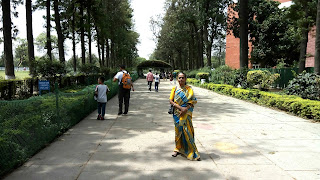We – my wife and I – were on a tri-city sojourn in Chandigarh,
Shimla and Kufri this summer between April 19 and 25, 2018. Chandigarh is reputed to be a well-planned
city. Shimla is a world famous summer
retreat. Kufri is emerging as a tourist
paradise with many modern resorts having come up. It was our first visit to
these places.
 |
| An artificial waterfall in the Rock Garden, Chandigarh |
THREE GARDENS, A LAKE AND A TEMPLE
(By Subbaram Danda)
Chandigarh was the first on our itinerary. It is located in the foothills of the
Shivalik range of the Himalayas. Meaning the “Fort of Chandi,” its name is
derived from an ancient temple there called Chandi Mandir devoted to Goddess
Chandi.
Administratively, it is unique. While being a union territory, it is also the
capital of two north Indian states of Punjab and Haryana. The first planned city in post-independence
India, it was designed by the Swiss-French architect Le Corbusier. His creation – a giant Open Palm– has become
the city’s symbolic icon.
Rock Garden
Though the city has many tourist attractions, the most
visited is the Rock Garden spread over 40 acres. Also known as Nek Chand’s Rock Garden after
its founder, it is a garden of colourful sculptures of a different kind -- made
wholly of waste materials like broken pieces of porcelain, pottery, rocks, metals,
auto parts, wood and bangles. One can
find figurines of dancers, musicians, boys, girls, animals and birds.
We passed through a maze of lanes and narrow arch ways
to see the exhibits. It is a great open
air display of unusual pieces of art. An
outstanding feature of the Rock Garden is an artificial waterfall made possible
through diversion of water from a nearby lake.
This is the most sought-after site for photo enthusiasts. We took about
a couple of hours to leisurely walk through the whole area. It is said to clock 5,000 visitors every day.
 |
| A sculpture in front of the Rock Garden paying a tribute to its creator |
 |
| The artificial waterfall in the background |
 |
| Sculptures of different kinds |
 |
| Peacocks |
 |
| A gallery of dancers |
 |
| School boys in uniform |
 |
| Through long-winding ways |
 |
| Figurines of men and animals |
Sukhna Lake
Close to the Rock Garden lies a serene water-body
called Sukhna Lake, surrounded by lush greenery. Stretching across 3 km, the lake was formed
in 1958 by damming a stream flowing from the Shivalik hills. Water sporting activities like boating, yachting
and water-skiing are prominent here. There
is a children’s play area too. The
promenade on the shores of the lake attracts a stream of joggers and walkers in
the morning and evening.
 |
| Boats ready to take visitors on board |
 |
| Serene environment |
 |
| The palm -- the icon of Chandigarh in the lake premises |
Rose Garden
About four kms from the Rock Garden is the sprawling Rose
Garden, said to be the largest one of its kind in Asia dedicated to roses. It is claimed that the garden has more than
32,500 plants, representing 825 varieties of roses. Named after former President of India Zakir
Hussain, it also houses several herbal plants.
Unfortunately, when we visited, several plants and
their flowers were in a state of withering. However, the vast layout with neatly trimmed
lawns and paved pathways was appealing.
 |
| A sign in front of the garden |
 |
| Entering the garden |
 |
| Withering plants and flowers |
 |
| Neat benches and lawns |
 |
| Camel rides outside the garden |
Manasa Devi
Temple
Our next visit was to a famous temple, set against a
scenic backdrop, dedicated to Manasa Devi, a form of Shakti, at Panchkula in
the state of Haryana near Chandigarh. Constructed
by Maharaja Gopal Singh during 1811-1815, it is currently administered by the
state government.
The sanctum is accessed by climbing a long flight of
stairs. The temple is so popular that we
had to wait in a long queue to have darshan of the Goddess. Huge crowds are
said to throng the temple during auspicious days, especially at the time of the
Navaratri melas.
Manasa Devi deity
 |
| Outside the sanctum |
 |
| In the temple complex |
Pinjore
Garden
Slightly away from Chandigarh lies the 17th
century Pinjore Garden. It is a
picturesque site with a long flowing water channel, flanked by paved paths, flower
beds, lawns and tall trees. Different
types of pavilions across the channel at intervals add to the grandeur of the whole
place.
Pinjore Garden was created by the foster brother of
the Mughal emperor Aurangazeb to serve as a summer retreat for the king. Far later, it was extended and reconstructed
by Maharaja Yadavindra of the then State of Patiala. At present it is a good tourist
attraction. A children’s play area with
various rides outside the proper garden is a special addition. Camel rides are well patronized.
 |
| The long central waterway flanked by paved pathways and lawns |
 |
| At another pavilion |
 |
| At the children's play area |
There are also some other attractions like
International Dolls Museum, Cactus Garden and Art Gallery but we had to skip them
for want of time. We were happy we had covered
the important ones. (Ends)
(Our tri-city sojourn will continue)
May 08, 2018
May 08, 2018



